|
|
|
 |
|
|
Reasons To Be Cheerful - Part III
Readers looking for a "Best Sound" list are hereby advised to look elsewhere. It's impossible to listen to all the systems on display under circumstances that would warrant the kind of fine-grained distinctions these lists call for. The best I can do is to offer up my choice for the:
Most Ill-Mannered Behavior at the Show
which goes to the Merlin room. Located on the second floor of one of the Alexis Park's many wings, the presentor left the door open and played music at levels that I would guess regularly approached 110dB. Every other exhibitor on the floor had to keep his door closed, which was conducive neither to doing business nor to entertaining potential visitors and guests. I simply don't understand the behavior which was both unfair to others and self-defeating in that the ear-piercing volumes did nothing to display the equipment to good effect.
|
|
|
|
Sound and Spirit: There was a surprising amount of deliciously good sound at the show - more than I had expected to find, in fact. Veteran showgoers are often looking for something special to knock them off their feet. If that were the standard, the sound would come off as a bit disappointing. On the other hand, I came to the show expecting the worst. By any measure, the rooms at all show sites are grim. The walls are thin; the floors mostly carpet over concrete; windows dominate and so on. And the furnishings and decorations? Yuck.
With so much of the "infrastructure" of good sound working against exhibitors, the quantity and quality of good sound was both surprising and refreshing. If the sound was in general pretty good, the spirit was better still - and even more difficult to explain. I grew up in a retail business family. My experience was that the mood in the family was largely a function of the health of the family business: Good business, good mood; bad business, stay away from Dad.
|
|
|
 |
|
Well, the stock market may be heading back up, but the audio business does not seem to have rebounded nearly as well. Go figure. And now, for my:
Hopelessly Incomplete Impressions of the Sounds of the Shows
|
|
|
Sources: Turntables
Whereas the aluminum disc was still the favored source -- after all, they are convenient, easy to use, and to be honest, don't sound so bad either -- a surprising number of rooms were spinning LPs, sometimes even as a primary source. Among the choice turntables on active duty were those from Pluto, Roksan, SOTA, Walker, dps, Clearaudio, Redpoint, Teres and Kuzma.
The Redpoint kept the magic afloat in two Innersound rooms, one at the Alexis Park, one at the Aladdin where the boys from Boulder were unveiling their new product line - and an impressive-sounding lineup it is.
The often and justly praised Walker table was wooing showgoers paired with the ultra-dynamic Zingali horn-loaded loudspeakers and Viva 845 amps from Italy.
The Roksan TMS is something of an engineering marvel. At the show, I spent several hours with the designer as he put the TMS together, explaining its design features and the choices he made. In my own rig, I use a Roksan Shiraz cartridge. I was thus anxious to hear it play on its home turf. Alas, the Shiraz cartridge arrived with a limp and had to be placed on the disabled list. A Corus was substituted and the sound of the table playing into the unassuming but very good Gradient Revolution loudspeakers was excellent but not dynamic and robust - distinct virtues of the Shiraz.
My buddy Steve and I spent a good deal of time in the Horning/Tom Evans/Kuzma room where a new linear tracking arm for the Kuzma table was being introduced. Steve and I were given a tour of the armaments by Mr. Kuzma himself and both came away extremely impressed. Kuzma claims to have solved a variety of problems associated with linear trackers, and an initial listening, though brief, gave us no reason to doubt his claims.
Like most showgoing analogue guys, I had only heard of but not yet actually heard the famed Pluto turntable from the Netherlands. This table graced the Duevel/Klimo room to produce a full, rich, detailed and dynamic yet altogether natural sound that I found utterly engrossing. Unfortunately, the Pluto cartridge did not arrive intact and a Clearaudio was substituted instead. Having never heard the complete Pluto setup, I cannot say what was missing, but the sound was plenty good as it was.
|
|
 |
|
 |
|
 |
|
 |
|
The most repeated claim I heard during the show? That last year, more LPs were sold than SACDs and DVD-A's combined. Judging by the relatively small number of hi-rez machines in evidence, I would not be surprised if the claim were true. I ditched my own SACD player last year and haven't missed it yet.
|
|
 |
Sources: Digital
It may sound odd, but CD appears to be making a comeback; or better, it has met the challenge of the hi-rez formats and survived nicely. Newer DACs on the market continue to reveal just how much good music is available from the very unfashionable RedBook standard. The Zanden DAC Model 5000 MkIV contributed mightily to the glorious, seductive sounds coming from the Audiopax room. Zanden also took the show as an opportunity to introduce the gorgeous new Model 2000 transport, currently spinning disks, I'm told, in Taos at the home of our publisher. There are certain advantages to being the publisher and editor of 6moons.
I had a brief chat with David Chesky towards the end of the show. We had run into one another at a couple of rooms earlier. First question he asked me was, "Did you have a chance to listen to the sound at the Audiopax room?" I said I had, and that it was easily among the most satisfying I'd heard. He stopped me as I was about to heap praise on the newly introduced speaker and said, "Oh that DAC; I am sure it is a bit colored, but it is fabulous." I couldn't disagree.
The Reimyo one-box CDP-777 by Combak Corporation of Japan was teamed with the new Reimyo line-level tube preamp and 300B amplifier. The full potential of this system remained unrealized as the speakers were not up to the challenge. The boys from Combak were able to borrow an incompletely broken-in pair of Reference 3a speakers for an after-hours listening session. I was able to attend it and thus get a better sense of what the system could do. The Reimyo is a bit more neutral than the Zanden, but not quite the heartthrob.
The Reimyo DAC is the most analogue-sounding digital front end I know - but not by much. Audio Logic's 24 MXL DAC from the mind of Jerry Ozment -- who remains something of an underground digital guru in these parts -- is a close second. The 24 MXL is transformer-coupled and represents another step forward in Ozment's attack on the digital state of the art.
The Zanden DAC comes in at around $10K; the Reimyo at around $5.5K; and the Audio Logic at $4K. These are all extraordinary but not inexpensive products . If you are looking for "great sound at a great price" as they say, I can confidently send you in the direction of Birdland.
Birdland introduced a potentially extraordinary product, the Odeon-Platinum DAC/ full-function preamp. It's basically an upgraded Odeon Ag DAC with onboard line and phono stages. Historically, Birdland products sounded great but rarely garnered style points. Not this time; this was one of the most beautifully styled pieces I saw at the entire show. The price of the piece remains TBA, but seemed to be steadily rising as the event progressed from first to last day. The Odeon Ag with volume control goes for $1.4K; the Odeon-Platinum is expected to come in somewhere between three to four times that.
Ensemble introduced a new and quite beautiful Dirondo transport that interacted synergistically with their own excellent DAC to produce a lively and engaging sound in an all-Ensemble room. Good music; good products; good sound; good looks - and very nice people to boot: A winning combination indeed.
I found nothing to complain about from CD front-ends in general. Digital duty at the show was ably handled, often by Audio Aero, Bel Canto, Esoteric, Electrocompaniet and MSB.
|
|
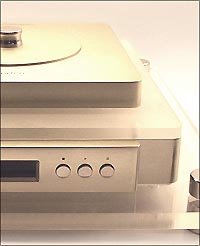 |
|
 |
|
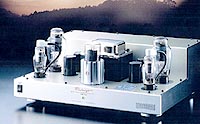 |
|
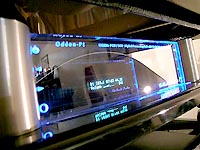 |
|
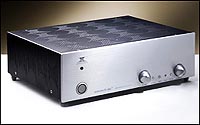 |
|
|
As an analogue guy, I found much on the digital side to like as well as to admire.
Electronics:
I am a holist. That makes me reluctant to evaluate audio components independently of how they interact with the other components in the system. It's a good deal easier to talk about the sound of a system at the show than it is to isolate the sound of a particular component. You go into a million rooms each decked out with components the sound of which, at best, you are only marginally familiar with. Then you try to explain what was good or bad about the sound in that room by attributing it to this or that component.
More often than not, the best you can hope to do is judge the sound of a system in a room on a particular day - nothing that invites broad generalizations. I find it particularly difficult to make judgments about individual components in rooms with other components I don't already know well. So I will try to confine myself to commenting on rooms with at least some products whose sonic signature I was reasonably well acquainted with.
|
|
|
Joe Fratus does several things extremely well: Cooking, he tells me, is one of them. Conversation is another. The guy is a pleasure to be around - and not just because he was born in Brooklyn. As far as his amps go, he typically does a great job on transformers and an even better job on aesthetics. His amps are of two sorts: Crystalline and transparent; warm and lush. The Art Audio PX25 amp is by my lights his very best and falls into the first category; his Carissa 845 amp is among his most recent successes and falls into the second.
Art Audio amps were ubiquitous at the show, paired with speakers as diverse as the very promising new full-range DeVore Silverback reference three-way; the unusually designed but warm and natural-sounding WHT loudspeaker imported by CC-Audio; to various Cain & Cain loudspeakers. His amps sounded best when paired with the DeVore and WHT reference, where the Diavolo and Jota, respectively, were carrying the work load. Both of these speakers will bear further attention. There is something very special going on with the WHT that requires further investigation. (Three moonies alone already expressed an interest in reviewing these. Srajan, you decide.)
Atma-Sphere OTLs were hard at work in the Glacier Audio rooms driving the new Gilmore speakers. Gilmore wins the award for the most tasteless advertisement to appear in an audio journal in the new millennium. The ad served two purposes, however: One conscious, the other (I would hope) not. The ad drew lots of attention to the Gilmore speakers (conscious). Because of its utter tastelessness, I am guessing that it drove down expectations (unintended beneficial consequence), including mine. The speaker benefitted not just from lowered expectations but also from a fine SOTA turntable front-end, and by being driven by the very fine Atma-Sphere OTLs.
I am a fan of OTLs; and Atma-Sphere is consistently among the best-sounding I have heard. I've owned several OTLs over the years, but I am not sure why it is better to have an audio signal run through a couple of dozen tubes (that are not likely to be matched for very long if ever) than pass it through a couple of tubes and a very well designed output transformer? There were more output tubes in the statement Atma-Spheres than one could count using all of one's fingers and toes.
The gorgeous Joule Electra OTL monoblock made beautiful music in conjunction with the Joseph Audio Pearl, but there were limits on the extent to which the combination could reproduce the bottom octaves. Whatever the limits, the sound was captivating. There were several other excellent tube amps contributing to wondrous sounds. Many of the best sounds were produced by well-known and familiar tube amplifiers: VTL in the VTL/Wilson room; BAT in the Avantgarde/BAT room; Audionote Japan and Audionote UK in separate Audionote rooms.
At the other end of the tube amp/preamp price range sit comfortably the products from Eastern Electric. One day I walked into the Audio Advancements room and listened to the little Omega speakers driven by the well-known Sun Audio 2A3 amp. Frankly, I found the sound a bit sleepy and uninvolving. Came back a day later - same speakers driven by the mini Eastern Electronics amp and preamp combination: The whole sound came alive and was very engaging. If you are looking for low- priced tube amps that knock out around 10 watts/side, your search may well begin and end here.
Count me among those who resist the idea that tubes add an unnatural, euphonic bloom to the midrange that's seductive but inaccurate. I don't know how many reviewers -- even those who love tubes -- buy into this claim unreflectively. Doing so basically concedes the virtues of accuracy and neutrality to solid state amps. But why? Why isn't it at least as likely that solid state amps are recessed in the midrange? Depends on your baseline, doesn't it? When comparing both with unreproduced sound in nature, tubes are closer to the real thing at least to my ears. Or maybe, voices in nature display a euphonic but unnatural bloom and warmth?
While you're counting, include me among those who also resist the idea that tubes come in colors whereas solid state is black and white. Solid state amps are at least as colorful as tubes. They come in dark and light, warm and cold, rich and thin, dynamic and reserved; just like tubes. This doesn't mean I dislike all solid-state amps and love all tube amps. Far from it. For example, I have never heard a Jeff Rowland amp I didn't like. At the show, Rowland teamed his new miniscule monoblock power amps with the massive JMlab speakers featuring the Beryllium tweeter to produce a very relaxed but detailed sound. Rowland amps have not received the recognition they deserve here in the States - but I am not sure that the match with JM Labs is an ideal one.
Whereas Rowland amps are all about tone, Edge is all about speed and transients. The sound is somewhat less full-bodied but highly resolved without being fatiguing. I listened to the gorgeous new Edge integrated in the Bösendorfer room where it was being asked to do too much, its 80-or-so watts having to substitute for a 250-watt Manley tube amp at the last moment [which had those speakers sing when I was in said room - Ed.] - and in a large ballroom at the San Remo driving Epiphany speakers that looked uncomfortably similar to Nearfield Pipedreams. I wasn't sure that the big Epiphanies were of a quality comparable to the amps; and in any case, there were some problems integrating the subwoofers with the rest of the system. Still, one could hear many of the sonic attributes that make the Edge amplifiers special: Speed, detail, low noise floor and effortless micro-dynamics.
I was hoping to listen to several solid state amps that I had not heard before - Audionet from Germany and Vitus Audio from Denmark among them. I never located the Audionet room but spent a fair bit of time listening to the rather impressive Vitus SM 100 monoblock. These gorgeous amps check in at an even by HighEnd standards lofty $45K/pr and can be set up to run either in Class A or in A/B. The amps deliver a whopping 800 watts/side RMS in class A/B, or 100 watts in pure class A.
The Vitus amps were paired with the very large Soundlab U-1 loudspeakers - as big as Soundlabs get. I am partial to Soundlabs. There may be no speaker more capable of resolving inner detail and none that contributes less distortion to the sound. That said, these are humongous, and here they were in a small room that appeared smaller yet by their presence. Not an ideal setting for Soundlabs.
Not only are Soundlabs big, they are hungry devils as well. They eat amps for breakfast, lunch and dinner. Even so, the Vitus monos remained unfazed and drove them effortlessly. The sound was detailed, subtle, undistorted and oddly intimate. I would love to hear this combination in my home sometime - though my wife will likely have a different view. Vitus Audio is a newcomer to be reckoned with. It has the kind of suave and natural sound that suggests it would be as much at home driving dynamic speakers as it is at driving electrostatics. I couldn't help thinking how interesting it might be to mate the Vitus with the quite extraordinary but very different Acapella Violin or with a passive version of the new Innersound Kaya and Kachina hybrid electrostatics.
From the sublime to the affordable: Though hampered by too loud a display across the hall, Monarchy Audio electronics drove the Eminent Technologies LFT VIII hybrid loudspeakers to produce some of the most dynamic yet natural sound at the show. This was a sensational pairing of two bargains that have been around for a long time: Monarchy electronics and Eminent Technology speakers. Full range dynamic and natural sound. You can spend an awful lot more and get an awful lot less in return.
|
|
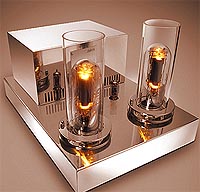 |
|
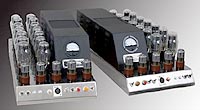 |
|
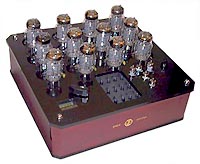 |
|
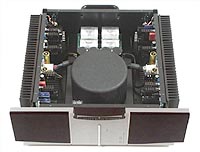 |
|
 |
|
 |
|
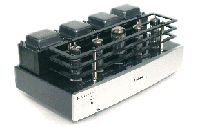 |
|
 |
|
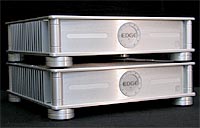 |
|
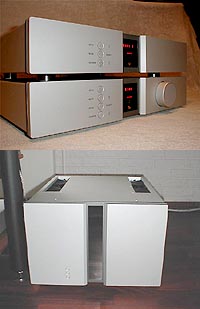 |
|
 |
|
|
 |
|
|
|
|
|
 |
|
 |
|
|
|
|
|
|
|
|
|
|
|
|